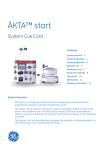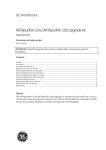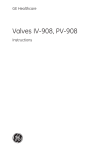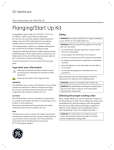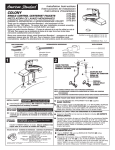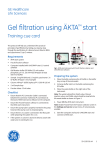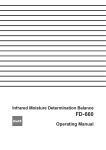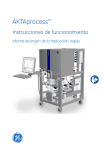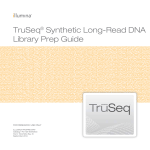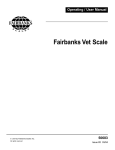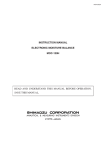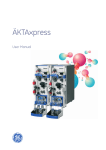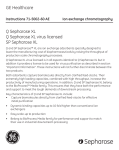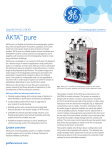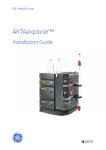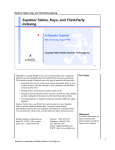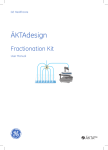Download AKTA Crystalキューカード
Transcript
GE Healthcare Cue card 11-0014-58 AB Automated multi-step protein purification System preparations Buffer suggestions Column preparations Purification protocols System maintenance Column cleaning Results and Evaluation ÄKTA 3D plus Kit System preparations This cue card describes general system preparations Table 3. Buffer positions for protocols A-E. To ensure the best results, use high purity water and Buffer Protocol inlet A B C D E chemicals. It is also recommended to filter the solvents A11 AC binding AC bindingAC bindingAC bindingAC binding through a 0.45 µm filter. A12 – B1 AC elution AC elution AC elution AC elution AC elution B2 – Available protocols Table 1. Steps in available protocols. – – GF – DS – IEX binding* IEX elution * The IEX binding buffer is also used for desalting. Protocol Included steps A Affinity (AC) step Wash system pump B Affinity (AC) gradient • Open System Control and select Manual:Pump. C Affinity (AC) – Gel filtration (GF) • Mark the instruction Pump Wash Explorer and select D Affinity (AC) – Desalting (DS) E Affinity (AC) – Desalting (DS) – Ion Exchange (IEX) Column positions Table 2. Column positions for protocols A–E. Column position appropriate pump inlets (e.g. A11, B1, B2). Each pump wash requires approximately 50 ml buffer. • Press Execute to start the wash. • Press End when the wash is completed. Note: If more than one InletA1 needs to be washed (e.g. A11 and A12) the pump wash must be repeated. Protocol A B C D E Sample Pump 2 AC(1) AC(1) AC(1) AC(1) AC(1) Presence of air bubbles in the pump and/or sample flow 3 AC(2) AC(2) AC(2) AC(2) AC(2) path will affect the flow rate. Air must therefore be remo- 4 AC(3) AC(3) AC(3) AC(3) AC(3) ved according to A or B below before starting the run. 5 AC(4) AC(4) AC(4) AC(4) AC(4) If the sample pump is empty and/or large amounts of the 6 AC(5) AC(5) AC(5) AC(5) – tubing is filled with air, proceed as in A below. 7 AC(6) – AC(6) AC(6) IEX 8 – – GF DS DS System Pump Fill buffer inlet tubings • Prepare required buffers according to the chosen To remove small amounts of air, proceed as in B on next page. A) Remove large amounts of air using a purge tubing Purpose: To remove large amounts of air in the sample flow path by using a purge tubing and syringe. purification protocol. Add extra volume for system • and column preparation. buffer. • Place the inlet tubings in the buffers according to • Set the sample valve V5 to any of the chosen sample Table 3. inlet ports. • If empty, purge the buffer inlet tubings manually • Disconnect the connector fitted to injection valve V1, according to P-900 User manual. port 4. Cue card 11-0014-58 AB Put all the sample inlet tubings into affinity binding System preparations continued • Connect the purge tubing to the same port. • Remove the 5 ml loop from the Loop_1 Valve (V8) and • Make sure the injection valve V1 is set to LOAD. replace it with a 10 ml loop. • *Draw buffer with the syringe until liquid enters the syringe. • *Switch the sample valve V5 to the next sample inlet tubing to be filled. • Repeat the 2 steps above (marked with *) for the remaining sample inlet tubings. • Disconnect the purge tubing. • Connect the original connector to the port. B) Remove small amounts of air from the sample tubing Purpose: To remove small amounts of air in the sample flow path by running the sample pump manually. • Put all the sample inlet tubings into affinity binding buffer. • Open System Control and select Manual:Flowpath. • Choose the instruction SampleValve, select the appropriate position and press Execute. • Select Pump and choose SampleFlow. • Enter an appropriate flow rate (e.g. 1 ml/min) and press Execute. • When the selected inlet is filled with solution, change sample valve position and fill all sample inlets to be used the same way. • When all sample inlets have been filled, set sample valve position to S8 and run the sample pump at flow rate 40 ml/min for 1 min to make sure that no air remains in the sample flow path. Note: If the loop is empty, fill it with buffer before the purification. Fill it manually with a syringe or use the template ”System and Loop wash”. • Create a method and check Show details in the Run Setup dialog. • Change volumes for the variables displayed in the table below. Table 4. Variables to change value of, if using a 10 ml loop instead of the default 5 ml loop in Loop_1 Valve (V8). Change values for all protocols that are used. Default1 New2 Block/Variable (ml) (ml) Wash_Loop1_Che/Wash_Volume_Loop1_Che325 50 or Wash_Loop1_GST/Wash_Volume_Loop1_GST325 50 Hold_Until_Peak_Less_Than/Max_CollectionVolume 3.5 6.5 Inject_Collected_peak/Loop_1_Volume 4 7 Delay_inject_selected_peak/InjectionDelay 5 10 1 The default values are for 5 ml HiTrap columns. 2 The new values are examples that are useable if using a HiPrep Desalting or a HiLoad Superdex 26/60 in the second step. 3 Depending on the type of column used. Change loop in Loop_1 Valve (V8) By default, the 5 ml loop is connected to Loop_1 Valve (V8). If running AC-DS or AC-GF with large columns and large protein amounts, it is possible to increase the yield by using a 10 ml loop instead. Cue card 11-0014-58 AB Buffer suggestions and column preparations This cue card describes how to prepare different columns before running a protocol Column preparations To ensure the best results, use high purity water and Purpose: To charge new or stripped HiTrap Chelating HP chemicals. It is also recommended to filter the solvents or HisTrap columns with metal ions (e.g. Ni2+, Co2+ or Cu2+). through a 0.45 µm filter. Several columns can be prepared automatically. Buffer suggestions Create the method AC buffer suggestions for His-tagged proteins • If performing... suggested buffer binding using 50 mM Tris-HCl pH 7.5, 0.5 M NaCl, HisTrap20-40 mM imidazole1) binding using 50 mM Tris-HCl pH 7.5, 0.5 M NaCl, HiTrap Chelating 5–40 mM imidazole1) elution 50 mM Tris-HCl pH 7.5, 0.5 M NaCl, 500 mM imidazole 1) The imidazole concentration is protein dependent. Affinity Columns Metal ion charging Open Method Editor and select Template under File:New. • Select the Metal Ion Charging 1ml or 5ml template and press OK. • Open the Scouting page. Use Add to create the B1 A11 number of runs equal to the number of columns that should be charged. Note: Even if only one column will be used, a scouting AC buffer suggestions for GST-tagged proteins run still has to be added. If performing... • andDefine wash column positions buffer, for each run. binding using GSTrap HP or FF elution suggested buffer 50 mM Tris-HCl pH 7.5, 150 mM NaCl, 1 mM DTT 50 mM Tris-HCl, 0.15 M NaCl, 1 mM DTT, 10 mM reduced gluthathione, pH 8 Affinity binding Affinity elution buffer, 150 ml 100 ml Note: Default Column Position is set to Position1Bypass, which means no column. • Save the method. DS buffer suggestions Prepare the system If preparing for... • Prepare required solutions (see Figure 1). • Connect the chelating columns at defined column positions. • Place the inlet tubings in the solutions according to AIEX suggested buffer 50 mM Tris-HCl pH 8.0 CIEX20 mM MES pH 6.0 protein storage include e.g. 10% glycerol in a suitable buffer (e.g. 50 mM Tris-HCl, pH 7.5, 150 mM NaCl) IEX buffer suggestions If for example... suggested buffer (depends on the pI of the protein) binding to AIEX 50 mM Tris-HCl pH 8.0 binding to CIEX20 mM MES pH 6.0 eluting from AIEX 50 mM Tris-HCl pH 8.0, 1 M NaCl Figure 1. • Fill the inlet tubings S1, S2, and S8 and purge the sample pump according to the instructions in the “System preparations” cue card. Start the method. The method takes approximately 15 minutes/column to run. eluting from CIEX20 mM MES pH 6.0, 1 M NaCl GF buffer suggestions If preparing for... suggested buffer further studies protein storage a suitable buffer, e.g. 50 mM Tris-HCl pH 7.5, 150 mM NaCl include e.g. 10% glycerol in a suitable buffer (e.g. 50 mM Tris-HCl pH 7.5, 150 mM NaCl) S1 S2 S8 Water, 0.7 l Metal solution, 100 ml (e.g. 0.1 M NiSO4) Affinity binding and wash buffer, 0.5 l Fig 1. Solutions required to run the “Metal Ion Charging” template. Cue card 11-0014-58 AB Buffer suggestions and column preparations continued Affinity blank run Purpose: Prior to a first time usage of an affinity column (GSTrap FF, GSTrap HP or a newly metal charged HiTrap Chelating HP or HisTrap) it is recommended to run a blank run. This ensures a well-conditioned and equilibrated column ready for chromatography. Ion exchange, Desalting and Gel filtration columns Equilibrate columns Purpose: To remove EtOH and equilibrate columns with buffer. Prepare the system Create the method • Open Method Editor and select Template under File:New. • Select the Affinity Blank Run 1ml or 5ml template and press OK. • Prepare sufficient volume of the required buffer, see Table 1. • Place the inlet tubing (e.g. A12) in the equilibration buffer and fill the inlet according to the system pump instructions given in the “System preparation” cue card. • Connect the columns. • Open the Scouting page. Use Add to create the number of runs equal to the number of columns that should be equilibrated. Select to wash inlet A11 and B1 in the first run. Manual run Note: Even if only one column will be used, a scouting Equilibration of columns is performed manually from run still has to be added. System Control. • Define column positions for each run. Note: After each selection below always press Execute. Note: Default Column Position is set to • Select Alarm_Pressure in Manual:Alarms&Mon, and Position1Bypass, which means no column. key in HighAlarm, see Table 1. Save the method. • Select BufferValveA1 (A12) in Manual:Flowpath. • Prepare the system • Select appropriate ColumnPosition in Manual:Flowpath. • Prepare required buffers, see Figure 2. • Select Flow in Manual:Pump, key in appropriate flow, • Place the inlet tubings in the buffers according to see Table 1. Figure 2. • Select End_timer in Manual:Other and choose • If empty, purge the inlet tubings (A11 and B1) Acc volume, key in appropriate Timeout volume, see according to the system pump instructions in the Table 1. “System preparations” cue card. • When the first column is ready, repeat for the next • Connect the affinity columns at defined column column to be equilibrated. positions. Note: To make automated methods, see UNICORN™ User Manual. Start the method. The method takes approximately 10 minutes/column to run. Table 1. Recommended HighAlarms, Flow rates and Equilibration volumes for different columns, when running ÄKTA 3D plus Kit including a 0.2 MPa flow restrictor. Flow rate Flow rate High Alarm removing EtOH equilibration Column (MPa) (ml/min) (ml/min) A11 Affinity binding and wash buffer, 150 ml B1 Affinity elution buffer, 100 ml Fig 2. Buffers required to run the “Affinity Blank Run” template. Timeout Equilibration volume (ml) HiLoad 16/60 0.5 0.5 1.0 360 HiLoad 26/60 0.5 1.3 2.5 954 159 HiPrep 26/10 0.35 7.5 15.0 HiTrap, 1ml 0.5 0.5 1.0 5 HiTrap, 5ml 0.52.5 5.0 25 RESOURCE™, 1ml 1.52.0 4.0 5 RESOURCE, 6ml 1.5 6.0 30 3.0 Mono Q™ 5/50 GL 4.0 1.0 2.0 5 Mono S™ 5/50 GL 4.0 1.0 2.0 5 Cue card 11-0014-58 AB Affinity binding and wash buffer, 1.2 l Affinity elution buffer, 0.5 l Protocol A: Affinity – step elution This cue card describes how to run this specific purification protocol Bypass HiTrap, sample 1 Before starting a purification protocol make sure to prepare 2 system and columns according to the instructions on HiTrap, sample 2 preparations cue cards. 1 Prepare your UNICORN method and select purification • Choose columns. • Indicate your running condition; room temperature or cold room. • Press Finish to obtain the purification method. • It is possible to change default values in the method, if needed. Check the Show details box. For more details, see ÄKTA 3D plus Kit User Manual. • Save your method. Fig 2. Column connections at column valves V2 and V3. Bypass HiTrap, Prepare and load samples sample 1 1 8and clarify them using Prepare your samples centrifugation and/or filtration through a 0.45 µm • 2 filter. HiTrap, sample 2 protocol according to the ”Buffer suggestions and column preparations” cue card. • Place buffer inlets as shown in Figure 1 and make sure your system is prepared as described in the “System preparations” cue card. • Connect selected columns as shown in Figure 2 and prepare them according to the “Buffer suggestions 6 5 4 Prepare the sample pump accordingHiTrap, to the sample 5 ”System preparations” cue card. Gently transfer each sample inlet tubing into each sample according to Figure 3. HiTrap, HiTrap, Make sure no air enters the tubing. sample 4 sample 3 S1 S2 S3 S4 S5 S6 Prepare buffers required for this protein purification 7 3 2 Prepare your system before a run • HiTrap, sample 6 • Sample 5 Press Next. HiLoad Superdex, sample 1–6 HiTrap, sample 4 HiTrap, sample 3 Sample 6 • HiTrap, sample 5 Sample 4 Mark the number of samples 1 to 6 to be purified. 7 6 Sample 3 • 5 Sample 1 protocol A) Affinity (Step). 4 Sample 2 Open the method wizard 8 3 the system preparations, buffer suggestions and column • HiTrap, sample 6 1 S8 Affinity binding and wash buffer, 0.5 l Fig 3. Sample placement at the sample valve V5. and column preparations” cue card. 4 Start the method • Load the fraction collector with four 96-well micro- • plates (2 ml). You will also need to load the fraction collector with 50 ml fraction tubes to collect the In the start protocol: second wash of the affinity column. For more details, see ÄKTA 3D plus Kit User Manual. Start your prepared method. • Key in sample ID for the proteins on the variable page. Each chromatogram will be named after the sample ID. 5 Evaluate results A11 Affinity binding and wash buffer, 1.2 l B1 Affinity elution buffer, 0.5 l Fig 1. Buffer inlets and maximum volumes needed, see ÄKTA 3D plus Kit User Manual for details. Cue card 11-0014-58 AB • How to view the results in an easy way, and how to calculate protein concentrations, is described in ÄKTA 3D plus Kit User Manual and on the “Results and evaluation” cue card. Protocol B: Affinity – gradient elution This cue card describes how to run this specific purification protocol Bypass HiTrap, sample 1 Before starting a purification protocol make sure to prepare 2 system and columns according to the instructions on 1 8 4 5 the system preparations, buffer suggestions and column HiTrap, sample 2 preparations cue cards. 7 6 3 HiTrap, sample 5 1 Prepare your UNICORN method HiTrap, sample 4 HiTrap, sample 3 • Open the method wizard and select purification protocol B) Affinity (Gradient). • Mark the number of samples 1 to 5 to be purified. • Press Next. • Choose columns. • Indicate your running condition; room temperature or cold room. • Press Finish to obtain the purification method. • It is possible to change default values in the method, inlet tubing into each sample according to Figure 3. binding and Make sureHiTrap, no air enters Fig 2. Column connections at column valves V2 and V3. Bypass Prepare andS4loadS5samples S2HiTrap, S3 S1 protocol according to the ”Buffer suggestions and column preparations” cue card. • Sample 5 Sample 4 Affinity sample 3 S1 S2 S3 S4 S5 Sample 5 •Prepare buffers required for this protein purification Sample 3 Sample 1 2 Prepare your system before a run HiTrap, preparations” cue card. Gently transfer each sample sample 5 Sample 4 Save your method. 6 the sample4 pump according to the ”System 5 Sample 3 • Prepare HiTrap, sample 2 Sample 2 details, see ÄKTA 3D plus Kit User Manual. 7 3 Sample 1 if needed. Check the Show details box. For more 2 fugation and/or filtration through a 0.45 µm filter. • 1 8and clarify them using centri- Prepare your samples Sample 2 • S8 sample 1 wash buffer, theHiTrap, tubing. 0.5 l sample 4 S8 Place buffer inlets as shown in Figure 1 and make sure your system is prepared as described in the “System preparations” cue card. • Connect selected columns as shown in Figure 2 and prepare them according to the “Buffer suggestions and column preparations” cue card. • Load the fraction collector with four 96-well microplates (2 ml). You will also need to load the fraction collector with 50 ml fraction tubes to collect the second wash of the affinity column. For more details, see ÄKTA 3D plus Kit User Manual. Affinity binding and wash buffer, 0.5 l Fig 3. Sample placement at the sample valve V5. 4 Start the method • Start your prepared method. In the start protocol: • Key in sample ID for the proteins on the variable page. Each chromatogram will be named after the sample ID. • Start your automated multi-step purification. 5 Evaluate results A11 Affinity binding and wash buffer, 1.2 l B1 Affinity elution buffer, 0.5 l • How to view the results in an easy way, and how to calculate protein concentrations, is described in ÄKTA 3D plus Kit User Manual and on the “Results and evaluation” cue card. Fig 1. Buffer inlets and maximum volumes needed, see ÄKTA 3D plus Kit User Manual for details. Cue card 11-0014-58 AB Protocol C: Affinity – Gel filtration This cue card describes how to run this specific purification protocol Before starting a purification protocol make sure to prepare system and columns according to the instructions on the system preparations, buffer suggestions and column preparations cue cards. • Connect selected columns as shown in Figure 2 and prepare them according to the “Buffer suggestions and column preparations” cue card. • Fill the fraction collector with four 96-well plates (2 ml) or 120 tubes (10 ml) depending on your choice of gel filtration column (see Table 1). You will also need to fill the fraction collector with 50 ml fraction 1 Prepare your UNICORN method tubes to collect the second wash of the affinity • Open the method wizard column (one tube per sample is needed). protocol C) Affinity (Step) – Gel Filtration. and select purification • Mark the number of samples 1 to 6 to be purified. • Press Next. • Choose columns. See Table 1 for recommendations. • Indicate your running condition; room temperature or cold room. • Press Finish to obtain the purification method. • It is possible to change default values in the method, if needed. Check the Show details box. For more details, see ÄKTA 3D plus Kit User Manual. • Save your method. Table 1. Recommended column combinations. Goal First column Second column HiLoad 16/60 Superdex™ 75 prep grade or HiLoad 16/60 Superdex 200 prep grade Up to HiTrap1, 5 ml 50 mg protein HiLoad 26/60 Superdex™ 75 Rack A with prep grade 10 and 50 ml or tubes HiLoad 26/60 Superdex 200 prep grade 1 B1 A12 B1 A11 Affinity Gel filtration Affinity binding buffer, elution and wash 2.7 l buffer, buffer, 0.5 l 1.2 l Affinity Affinity binding elution Fig 1. Buffer andinlets wash and maximum volumes buffer, buffer, 0.5 l plus Kit User1.2 Manual for details. l Rack C with micro titre plates and 50 ml tubes HiLoad Superdex, sample 1–6 Either of HiTrap Chelating HP, HisTrap, Any HiTrap, GSTrap FF or GSTrap HP can be used. Bypass HiTrap, sample 1 2 Prepare your system before a run 2 • Prepare buffers required for this protein purification 3 protocol according to the ”Buffer suggestions and column preparations” cue card. • Place buffer inlets as shown in Figure 1 and make sure your system is prepared as described in the “System preparations” cue card. Cue card 11-0014-58 AB needed, see ÄKTA 3D Frac-950 Up to HiTrap , 1 ml 10 mg protein 1 A11 HiTrap, sample 2 HiTrap, sample 6 1 8 4 5 7 6 HiTrap, sample 5 HiTrap, sample 4 HiTrap, sample 3 S1 S2 S3 S4 S5 S6 Sample 1 Sample 2 Sample 3 Sample 4 Sample 5 Sample 6 Fig 2. Column connections at column valves V2 and V3. S8 Affinity binding and wash buffer, 0.5 l HiLoad Superdex, sample 1–6 Protocol C: Affinity – Gel filtration continued 3 Prepare and load samples 4 Start the method • Bypass Prepare your samples and clarify them using sample 1 centrifugation and/or filtration through asample 0.456µm filter. • Prepare the sample pump according to the ”System 6 3 5 HiTrap, preparations” cue card.4 Gently transfer each sample sample 2 HiTrap, • HiTrap, 2 1 8 7 HiTrap, 5 accordingsample to Figure inlet tubing into each sample Make sure no air enters the tubing. S1 S2 S3 S4 S5 S6 Sample 1 Sample 2 Sample 3 Sample 4 Sample 5 Sample 6 In the start protocol: • Key in sample ID for the proteins on the variable page. Each chromatogram will be named after the sample ID. • Start your automated multi-step purification. 5 Evaluate results HiTrap, sample 4 HiTrap, sample 3 3. Start your prepared method. S8 • How to view the results in an easy way, and how to calculate protein concentrations, is described in ÄKTA 3D plus Kit User Manual and on the “Results and evaluation” cue card. Affinity binding and wash buffer, 0.5 l Fig 3. Sample placement at the sample valve V5. Cue card 11-0014-58 AB Protocol D: Affinity – Desalting This cue card describes how to run this specific purification protocol Before starting a purification protocol make sure to prepare system and columns according to the instructions on the system preparations, buffer suggestions and column preparations cue cards. 1 Prepare your UNICORN method • Open the method wizard protocol D) Affinity (Step) – Desalting. • Connect selected columns as shown in Figure 2 and prepare them according to the “Buffer suggestions and column preparations” cue card. • Load the fraction collector with four 96-well micro- plates (2 ml). You will also need to load the fraction collector with 50 ml fraction tubes to collect the second wash of the affinity column. For more details, see ÄKTA 3D plus Kit User Manual. and select purification • Mark the number of samples 1 to 6 to be purified. • Press Next. • Choose columns. See Table 1 for recommendations. • Indicate your running condition; room temperature or cold room. • Press Finish to obtain the purification method. • It is possible to change default values in the method, if needed. Check the Show details box. For more details, see ÄKTA 3D plus Kit User Manual. • Save your method. A11 A12 B1 B2 Affinity binding and wash buffer, 1.0 l Desalting buffer, 1.6 l Affinity elution buffer, 0.5 l CIEX elution buffer, 0.5 l Fig 1. Buffer inlets and maximum volumes needed, see ÄKTA 3D plus Kit User Manual for details. Table 1. Recommended column combinations. Goal First column Second column Frac-950 Up to HiTrap1, 1 ml2 × HiTrap DS Rack C with micro titre 10 mg or plates and 50 ml tubes protein HiPrep DS Up to HiTrap1, 5 ml2 × HiTrap DS 50 mg or protein HiPrep DS 1 HiPrep Desalting, sample 1–4 Rack C with micro titre plates and 50 ml tubes HiTrap, sample 1 Either of HiTrap Chelating HP, HisTrap, Any HiTrap, GSTrap FF or GSTrap HP Bypass can be used. 2 Prepare buffers required for this protein purification protocol according to the ”Buffer suggestions and column preparations” cue card. • Place buffer inlets as shown in Figure 1 and make sure your system is prepared as described in the “System preparations” cue card. 10 Cue card 11-0014-58 AB 8 4 5 HiTrap, sample 2 HiTrap, sample 5 HiTrap, sample 3 7 6 3 2 Prepare your system before a run • HiTrap, sample 6 1 HiTrap, sample 4 Fig 2. Column connections at column valves V2 and V3. HiLoad Superdex, sample 1–6 Protocol D: Affinity – Desalting continued 3 Prepare and load samples • 4 Start the method Bypass Prepare your samples and clarify them using filter. • Prepare the sample pump according to the ”System 6 3 5 HiTrap, preparations” cue card.4 Gently transfer each sample sample 2 HiTrap, and/or filtration through 2 1 8 HiTrap, asample 0.456µm • HiTrap, sample 1 centrifugation 7 5 inlet tubing into each sample accordingsample to Figure 3. Make sure no air enters the tubing. S1 S2 S3 S4 S5 S6 Sample 1 Sample 2 Sample 3 Sample 4 Sample 5 Sample 6 In the start protocol: • Key in sample ID for the proteins on the variable page. Each chromatogram will be named after the sample ID. • Start your automated multi-step purification. 5 Evaluate results HiTrap, sample 4 HiTrap, sample 3 Start your prepared method. S8 • How to view the results in an easy way, and how to calculate protein concentrations, is described in ÄKTA 3D plus Kit User Manual and on the “Results and evaluation” cue card. Affinity binding and wash buffer, 0.5 l Fig 3. Sample placement at the sample valve V5. Cue card 11-0014-58 AB 11 Protocol E: Affinity – Desalting– Ion Exchange This cue card describes how to run this specific purification protocol Before starting a purification protocol make sure to prepare system and columns according to the instructions on the system preparations, buffer suggestions and column preparation cue cards. • Connect selected columns as in Figure 2 and prepare them according to the “Buffer suggestions and column preparations” cue card. • Load the fraction collector with four 96-well microplates (2 ml). You will also need to load the fraction collector with 50 ml fraction tubes to collect the second wash of the affinity column and the IEX 1 Prepare your UNICORN method flowthrough. (Two tubes per sample are needed). For • Open the method wizard more details, see ÄKTA 3D plus Kit User Manual. protocol E) Affinity (step) – desalting – IEX. and select purification • Mark the number of samples 1 to 4 to be purified. • Press Next. • Choose columns. See Table 1 for recommendations. • Indicate your running condition; room temperature or cold room. • Press Finish to obtain the purification method. • It is possible to change default values in the method, if needed. Check the Show details box. For more details, see ÄKTA 3D plus Kit User Manual. • Save your method. Rack C with micro titre plates and 50 ml tubes Up to HiTrap1, 5 ml HiPrep Desalting 5 or 6 ml 50 mg IEX2 protein Rack C with micro titre plates and 50 ml tubes 1 A11 Affinity Desalting 1.0 l 1.6 l 2 3 HiTrap, sample 1 HiTrap, sample 2 1 HiTrap, sample 2 HiTrap, sample 3 6 RESOURCE Q, sample 1–4 Not used 5 1 8 4 5 7 6 Not used HiTrap, sample 4 HiTrap, sample 4 connections at column valvesS8V2 and V3. S1 S2 S3 S4 Sample 4 “System preparations” cue card. S2 S4 Fig 2.S3Column Sample 3 S1 Sample 4 sure your system is prepared as described in the Sample 3 Place buffer inlets as shown in Figure 1 and make HiTrap, sample 3 Sample 2 • 7 3 Sample 2 column preparations” cue card. 8 Bypass 2 Sample 1 IEX elution RESOURCE Q, sample 1–4 4 Sample 1 Prepare buffers required for this protein purification Affinity Bypass HiTrap, sample 1 2 Prepare your system before a run protocol according to the ”Buffer suggestions and IEX elution buffer, 0.5 l HiPrep Desalting, sample 1–4 AIEX for proteins with low pI, CIEX for proteins with high pI. • B2 Affinity elution buffer, 0.5 l HiPrep Desalting, sample 1–4 Either of HiTrap Chelating HP, HisTrap, Any HiTrap, GSTrap FF or GSTrap HP B1 A12 Desalting and IEX binding buffer, 1.6 l can be used. 2 B2 IEXmaximum elutionvolumes buffer, Fig 1. binding Buffer inletsand and needed, see and wash binding buffer, 0.5 l ÄKTA 3D plus Kit User forl details. buffer, buffer,Manual 0.5 First column Second column Third column Frac-950 Up to HiTrap1, 1 ml2 × HiTrap 1, 5 or 6 ml 10 mg Desalting IEX2 protein or HiPrep Desalting B1 A12 Affinity binding and wash buffer, 1.0 l Table 1. Recommended column combinations. Goal A11 S8 Affinity binding and wash buffer, 0.5 l Affinity binding and wash buffer, 0.5 l 12 Cue card 11-0014-58 AB HiPrep Desalting, sample 1–4 Protocol E: Affinity – Desalting – Ion Exchange continued Bypass HiTrap, sample 1 3 Prepare and load samples 1 RESOURCE Q, sample 1–4 8 4 Start the method • 2 and clarify 7 Prepare your samples them using • 6 through a 0.45 µm centrifugation and/or3 filtration Not used filter. sample 2 In the start protocol: • Prepare the sample pump according to the ”System preparations” cue card. Gently transfer each sample inlet tubing Make sure no air enters the tubing. 4 HiTrap, S1 S2 S3 S4 Sample 1 Sample 2 Sample 3 Sample 4 HiTrap, sample 3 into each 5 sample HiTrap, sample 4 according to Figure 3. Start your prepared method. • Key in sample ID for the proteins on the variable page. Each chromatogram will be named after the sample ID. • Start your automated multi-step purification. 5 Evaluate results S8 • How to view the results in an easy way, and how to calculate protein concentrations, is described in ÄKTA 3D plus Kit User Manual and on the “Results and evaluation” cue card. Affinity binding and wash buffer, 0.5 l Fig 3. Sample placement at the sample valve V5. Cue card 11-0014-58 AB 13 System maintenance and column cleaning This cue card describes how to clean your system and columns after performed protein purification To ensure the best results, use high purity water and chemicals. It is also recommended to filter buffers through a 0.45 µm filter. System and Loop Wash Purpose: To wash all used tubings within the system, including the loops. Create the method Create the method • Open Method Editor and select Template under File:New. • Select the Column CIP template and press OK. • Open the Scouting page. Use Add to create the number of runs equal to the number of columns that should be cleaned. Note: Even if only one column will be used, a scouting run still has to be added. • Define Column volume, Pressure limit, Regulation pressure, Flow rate and Column position for each Open Method Editor and select Template under run. See table 1 for recommendations. File:New. • Select the buffer inlets, flow rates and volumes for all • Select the System and Loop Wash template and solutions that will be used. Up to 10 steps per column press OK. can be performed. • Select up to two buffer inlets to be washed at the • Save the method. same time as the system (e.g. A11 and B1). Note: If more than one InletA1 needs washing (e.g. A11 and A12) we recommend to clean these inlets according to the “System Pump” instructions in the “System preparations” cue card before performing the System Wash. Sample inlet tubings must be washed separately according to the ”Sample Pump” instructions in the ”System preparations” cue card. • Save the method. • Prepare the system • Prepare a sufficient volume of each required solution. • Connect the columns at defined column positions. • Place the inlet tubings in appropriate solutions. • Fill the inlet tubings according to “System Pump” instructions in the “System preparations” cue card. Start the method. Table 1. CIP values to enter on the scouting page if using FR-902 flow restrictor. Prepare the system Column • Prepare a sufficient volume (0.4 l) of the wash solution. • Place the inlet tubings in the wash solution. Column volume (ml) Pressure limit (MPa) Regulation pressure1 (MPa) Flow rate RT2 (ml/min) Flow rate CR3 (ml/min) HiTrap 1 ml 0.96 0.5 0.45 1.0 0.8 HiTrap 5 ml 5.0 0.5 0.45 5.0 4.0 HiPrep DS 53 0.35 0.3 10 8.0 Start the method. RESOURCE 1 ml 0.97 1.5 1.3 4.0 3.2 The method takes approximately 10 minutes to run. RESOURCE 6 ml 6.0 1.5 1.3 6.0 4.8 Mono Q 5/50 GL 0.98 4.0 3.62.0 1.6 Column CIP (cleaning-in-place) Mono S 5/50 GL 0.98 4.0 3.62.0 1.6 Purpose: To clean contaminated columns. For column HiLoad 16/60 121 0.5 0.45 0.8 HiLoad 26/60 319 0.5 0.452.52.0 cleaning procedures and column storage instructions, please refer to the instructions supplied with each 1 Target pressure used by the pressure/flow regulation. Should be lower than 2 RT=room temperature 3 CR= cold room column or to our homepage: www.gelifesciences.com/ chromatography 14 Cue card 11-0014-58 AB 1.0 the pressure limit. System maintenance and column cleaning continued Affinity binding and wash buffer, 150 ml Affinity elution buffer, 100 ml Metal Ion Stripping (chelating columns) Prepare the system Purpose: To remove metal ions before regenerating the • HiTrap HP and HisTrap columns. To recharge the column, follow the instructions given on the “Buffer suggestions and column preparations” cue card. Note: Always remove metal ions before or right after storing the HiTrap Chelating and HisTrap columns in EtOH. Prepare required solutions, see Figure 1. • Connect the columns at defined column positions. • Place the inlet tubings in the solutions according to Figure 1. • Fill the inlet tubings S1, S3 and S8, and purge the sample pump according to instructions in the “System preparations” cue card. Create the method • Open Method Editor and select Template under Start the method. File:New. • Select the Metal Ion Stripping 1ml or 5ml template The method takes approximately 20 minutes/column to and press OK. • Open the Scouting page. Use Add to create the number of runs equal to the number of columns that should be stripped. Note: Even if only one column will be used, a scouting run still has to be added. • Define Column Position for each run. • Save the method. run. S1 S3 S8 Water, 0.5 l Metal stripping solution, (e.g. 50 mM EDTA), 100 ml Affinity binding and wash buffer, 0.5 l Fig 1. Solutions required for the “Metal Ion Stripping” template. Cue card 11-0014-58 AB 15 Results and evaluation This cue card describes how to open results and determine protein concentration and amount 1 Find and open the result files 2 Select curves to display • Right-click on the chromatogram and select Properties. • In the curve selection table select curves to be displayed (commonly; 1, 4, 6, 11 and 22). (If the Clear function is used, also remember to scroll down and • Use the Recent Runs or the Find tab, in the Evaluation module to locate the result file. • Click A result file – Sample loading chromatogram (11 below) Note: If you have entered the sample ID on the variable page, the sample ID will be shown in the – Purification chromatograms for each sample chromatogram heading. • Double-click a sample ID to open that specific sample chromatogram. • Press OK to confirm your selections. to expand the list for the result file. consists of: • Double-click a result file to open all included chromatograms. (The first chromatogram shows the loading of all samples onto the affinity columns. Each one of the remaining chromatograms shows the purification of one individual sample.) Note: To locate a specific sample, click the Find tab, enter sample ID and click Quick Find. 16 Cue card 11-0014-58 AB select curve 22.) 3 Pool fractions and adjust pooling • If required, maximize the sample window • Zoom in on the relevant fractions. . • Choose Operations:Pool to pool the fractions. The pooled fractions are listed in a table below the chromatogram and the pooled peaks are numbered sequentially in the chromatogram. Only adjacent fractions will be pooled. The fraction numbers for each pool are listed in the table as a range in retention order, e.g. A6–A7 etc. • If necessary, adjust pooling. Result and evaluation continued 4 Determine protein concentration and amount • Enter the real cell lengt of the UV cell in the Path Lenght (cm) field. Note: If the real cell lenght has been set direcly in Monitor UV-900, enter the nominal cell lenght (0.2 cm) instead. Pooling protocol • Enter the extinction coefficient manually by marking a pool and then typing the value in the extinction coefficient field. The concentration is given in mg/ml, or M, and amount is given in mg, or mmole, depending on the 5 Print or save the Pooling protocol coefficient used. The Pooling protocol can be used as a help when making • Click the Add to Pooling Protocol button to add the the physical pooling of the purified samples from the adjusted pools to the Pooling protocol. microplate. • Repeat the procedure for other chromatograms from the same, or other, result files. • Click the View Pooling Protocol button. • To print the Pooling protocol: Click the Print button to print the protocol on the default printer. • To save the Pooling protocol as a file: Click Export and save the protocol in one of the following formats: text (.txt), Excel (.xls), HTML (.htm). Cue card 11-0014-58 AB 17 Ordering information Product Pack Size Code No. HiTrap SP HP 5 × 1 ml 17-1151-01 HiTrap SP HP 5 × 5 ml 17-1152-01 HiTrap Q FF 5 × 1 ml 17-5053-01 HiTrap Q FF 5 × 5 ml 17-5156-01 HiTrap SP FF 5 × 1 ml 17-5054-01 HiTrap SP FF 5 × 5 ml 17-5157-01 please contact HiTrap DEAE FF 5 × 1 ml 17-5055-01 your local sales representative of GE Healthcare HiTrap DEAE FF 5 × 5 ml 17-5154-01 HiTrap CM FF 5 × 1 ml 17-5056-01 HiTrap CM FF 5 × 5 ml 17-5155-01 HiTrap ANX FF (high sub) 5 × 1 ml 17-5162-01 HiTrap ANX FF (high sub) 5 × 5 ml 17-5163-01 HiTrap Q XL 5 × 1 ml 17-5158-01 HiTrap Q XL 5 × 5 ml 17-5159-01 HiTrap SP XL 5 × 1 ml 17-5160-01 HiTrap SP XL 5 × 5 ml 17-5161-01 Mono Q 5/50 GL 1 × 1 ml 17-5166-01 Mono S 5/50 GL 1 × 1 ml 17-5168-01 ÄKTA 3D plus Kit User Manual 1 11-0014-57 Test Kit 280 nm (2 mm cell) 1 18-1129-63 ÄKTA 3D plus Kit Miniposter 1 11-0025-34 HiTrap Column Guide 1 18-1129-81 ÄKTAexplorer chromatography systems Data File 1 18-1124-09 Fraction collector Frac-950 Data File 1 18-1153-57 Handbook 1 18-1022-29 Gel Filtration Handbook 1 18-1022-18 Ion Exchange Chromatography Handbook 1 18-1114-21 Recombinant Protein Handbook 1 18-1142-75 GST Gene Fusion System Handbook 1 18-1157-58 Product Pack Size ÄKTA 3D plus Kit*, with software, valve (INV-907), air sensor (915-N), flow restrictor (FR-902) tubings, sample loops, fittings, instruction manual and cue cards 1 ÄKTAexplorer 100 Fraction collector Frac-950, complete with Rack A, 18 and 30 mm tubes Rack C, complete with bowl for 96-well microtitre plates** and 30 mm tubes 1 1 Code No. 11-0014-53 18-6083-00 18-6083-13 Supported Columns: Affinity chromatography HiTrap Chelating HP 5 × 1 ml 17-0408-01 HiTrap Chelating HP 1 × 5 ml 17-0409-01 HisTrap HP 5 × 1 ml 17-5247-01 HisTrap HP 5 × 5 ml 17-5248-02 GSTrap FF 5 × 1 ml 17-5130-01 GSTrap FF 2 × 1 ml 17-5130-02 GSTrap FF 1 × 5 ml 17-5131-01 GSTrap HP 5 × 1 ml 17-5281-01 GSTrap HP 5 × 5 ml 17-5282-02 Gel filtration HiLoad 16/60 Superdex 75 prep grade 1 × 120 ml 17-1068-01 1 × 120 ml 17-1069-01 1 × 318 ml 17-1070-01 HiLoad 16/60 Superdex 200 prep grade HiLoad 26/60 Superdex 75 prep grade HiLoad 26/60 Superdex 200 prep grade 1 × 318 ml 17-1071-01 Buffer exchange HiPrep 26/10 Desalting 1 × 53 ml 17-5087-01 HiTrap Desalting 5 × 5 ml 17-1408-01 Ion exchange chromatography RESOURCE Q 1 × 1 ml 17-1177-01 RESOURCE Q 1 × 6 ml 17-1179-01 RESOURCE S 1 × 1 ml 17-1178-01 RESOURCE S 1 × 6 ml 17-1180-01 HiTrap Q HP 5 × 1 ml 17-1153-01 HiTrap Q HP 5 × 5 ml 17-1154-01 18 Cue card 11-0014-58 AB Related products and literature: Affinity Chromatography Purifying Challenging Proteins Handbook 128-9095-31 * ÄKTAexplorer100 (with Pump P-960 and UNICORN 5.01 or higher) and Fraction collector Frac-950 (with Rack A and Rack C; Rack A is the standard rack supplied with Fraction collector Frac-950) are needed to use ÄKTA 3D plus Kit. ÄKTAexplorer 100 upgrades can be ordered from your local LabcrewTM representative of GE Healthcare. A representative of GE Healthcare is required to install ÄKTA 3D plus Kit. ** GE Healthcare recommends Greiner, PP-Masterblock, 2 ml, 96 well: 780270 Trouble shooting and useful hints can be found in the User Manual: 11-0014-57 AA. Cue card 11-0014-58 AB 19 www.gelifesciences.com GE, imagination at work, and GE monogram are trademarks of General Electric Company. GE Healthcare Bio-Sciences AB ÄKTA, DropDesign, GSTrap, HiLoad, HiPrep, HisTrap, HiTrap, Labcrew, Mono Q, Mono S, RESOURCE, Superdex, and UNICORN are trademarks of GE Healthcare companies. Björkgatan 30 751 84 Uppsala Sweden All third party trademarks are the property of their respective owners. © 2004–2007 General Electric Company – All rights reserved. First published Oct. 2004 All goods and services are sold subject to the terms and conditions of sale of the company within GE Healthcare which supplies them. A copy of these terms and conditions is available on request. Contact your local GE Healthcare representative for the most current information. GE Healthcare Europe GmbH Munzinger Strasse 5 D-79111 Freiburg Germany GE Healthcare UK Limited Amersham Place Little Chalfont Buckinghamshire, HP7 9NA UK GE Healthcare Bio-Sciences Corp. 800 Centennial Avenue P.O. Box 1327 Piscataway, NJ 08855-1327 USA imagination at work Elanders Östervåla 2007 Elanders Östervåla 2007 11-0014-58 AB 05/2007 20 Cue card 11-0014-58 AB Elanders Östervåla 2007 12345 Elanders Östervåla 2007 12345 Elanders Östervåla 2007 12345 Asia Pacific Tel: +85 65 62751830 Fax: +85 65 62751829 • Australasia Tel: +61 2 8820 8299 Fax: +61 2 8820 8200 • Austria Tel: 01 /57606 1613 Fax: 01 /57606 1614 • Belgium Tel: 0800 73 890 Fax: 02 416 8206 • Canada Tel: 1 800 463 5800 Fax: 1 800 567 1008 • Central, East, & South East Europe Tel: +43 1 972 720 Fax: +43 1 972 722 750 • Denmark Tel: +45 70 25 24 50 Fax: +45 45 16 2424 • Eire Tel: 1 800 709992 Fax +44 1494 542010 • Finland & Baltics Tel: +358 9 512 3940 Fax: +358 9 512 39439 • France Tel: 01 69 35 67 00 Fax: 01 69 41 98 77 • Germany Tel: 0800 9080 711 Fax: 0800 9080 712 • Greater China Tel: +852 2100 6300 Fax: +852 2100 6338 • Italy Tel: 02 26001 320 Fax: 02 26001 399 • Japan Tel: 81 3 5331 9336 Fax: 81 3 5331 9370 • Korea Tel: 82 2 6201 3700 Fax: 82 2 6201 3803 • Latin America Tel: +55 11 3933 7300 Fax: +55 11 3933 7304 • Middle East & Africa Tel: +30 210 96 00 687 Fax: +30 210 96 00 693 • Netherlands Tel: 0800-82 82 82 1 Fax: 0800-82 82 82 4 • Norway Tel: +47 815 65 777 Fax: +47 815 65 666 • Portugal Tel: 21 417 7035 Fax: 21 417 3184 • Russia & other C.I.S. & N.I.S Tel: +7 495 956 5177 Fax: +7 495 956 5176 • Spain Tel: 902 11 72 65 Fax: 935 94 49 65 • Sweden Tel: Elanders 018 612 1900 Fax: 018 612 1910 12345 • Switzerland Tel: 0848 8028 10 Fax: 0848 8028 11 Östervåla 2007 • UK Tel: 0800 515 313 Fax: 0800 616 927 • USA Tel: +1 800 526 3593 Fax: +1 877 295 8102 Elanders Östervåla 2007 GE Healthcare Bio-Sciences KK, Sanken Bldg. 3-25-1 Hyakunincho Shinjuku-ku Tokyo 169-0073 Japan




















